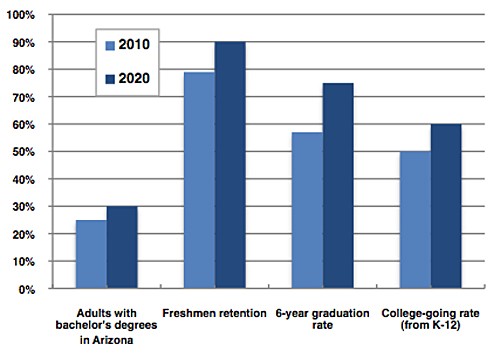If the Arizona Board of Regents has its say, there will be twice as many Arizona college graduates 10 years from now.
According to the board’s “”2020 Vision,”” a long-term strategic plan for the Arizona university system from 2008 until 2020, one of the major goals of the Arizona university system will be to double the amount of bachelor’s degrees awarded by Arizona universities over the next decade. Doing so would raise Arizona degree attainment to 30 percent of adults, above the projected national average of 29 percent in 2020.
In order to achieve these degree targets, the ABOR report says that undergraduate enrollment needs to rise to about 155,800 more between Arizona’s three universities, a 60 percent increase from current enrollment levels. The projected increase, which will take part over the next 10 years, would be the same as adding the number of students who currently attend Arizona State University to the state university system.
The U.S. Census Bureau projects that Arizona’s population will grow by 85.8 percent from 2000 until 2025, the second-fastest growth in the nation behind Nevada, and 60 percent above the 24.2 percent projected national average.
For the UA, some of these targets include growing main campus enrollment from current 39,058 to around 40,000. But much of proposed enrollment growth involves raising the number of students involved in alternative pathway degree programs, such as UA South.
The UA currently has about 1,500 students enrolled in alternative degree programs.
“”We are working to make sure that we have multiple educational pathways for students,”” said Melissa Vito, vice president for student affairs. “”So, while the main campus growth will move toward 40,000 to 42,000, primarily because of campus physical capacity constraints, we will continue to grow and develop other opportunities students will have to complete a University of Arizona degree and we anticipate that we will have around 10,000 students enrolled in these programs by 2020.””
These same goals are reiterated in the Arizona Higher Education Enterprise, a report released by the Council of Presidents in September, which consists of the presidents of Arizona’s universities and the president of the Board of Regents. This report details specific targets for enrollment growth over the next decade.
“”We’ve made a very intentional choice to focus precisely on our mission and our strengths as we think about growth opportunities and to really make sure that we don’t compromise either of those,”” said Mike Proctor, UA vice provost for outreach and global initiatives. “”We’re making sure that those are foundational to making growth decisions.””
The UA hopes to raise freshman retention rates to above 90 percent, compared to 78 percent last year, and six-year graduation rates to 70 percent, compared to from 58 percent last year, by 2020.
Despite projections for substantial state population growth over the next 15 years, Vito made it clear the UA is ready to adapt to changes in enrollment.
“”By diversifying our educational offerings we are attempting to plan for the growth of this state and the college-going populations,”” Vito said. “”We are not looking at curbing our enrollment, but rather are planning options that will give students opportunity in one of our programs either on or off campus.””
To cope with expanding enrollment growth the UA plans to expand current programs.
“”We will grow and diversify our academic support programs like Think Tank to offer more support to online learners and will work to find innovative ways for students to engage on campus,”” Vito said.
Both Vito and Proctor said the UA’s comparatively moderate growth projections are in part to the university’s geographical limitations on main campus.
Despite changes in enrollment, UA administrators are not worried about changing the UA’s mission or its goals.
“”I think our approach is pretty solid because we really are focused on that mission, not on growth for its own sake,”” Proctor said.
Proctor also cautioned that any projected enrollment growth is dependent on how much funding the UA receives from the state.
“”Clearly growth really requires a model partnership with the state,”” Proctor said, “”… there is a presumed base level of support to serve our students.””
The UA’s proposed increases are less drastic than Arizona State University’s, which hopes to grow campus enrollment to approximately 85,000 and total enrollment to around 120,000 by 2020. Northern Arizona University, by comparison, is proposing growth that will take its total campus population to 43,000, according to the Arizona Higher Education Enterprise report.









